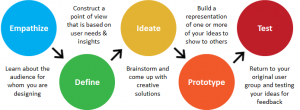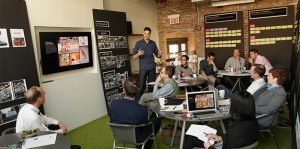Want to Innovate? Use Design Thinking
 The concept of design thinking can be described as a “way of thinking.” Herbert A Simson’s 1969 book ‘The Sciences of the Artificial’, and a book in design engineering by Robert McKim in 1973 titled ‘Experiences in Visual Thinking’, then in 1987 Peter Rowe’s book ‘Design Thinking’ all of these books describe methods and approaches used by architects and urban planners to design great cities. These people can think futuristically and that’s how the term ‘Design Thinking’ came and the early research data is collected from architects and urban planners on this topic. Design thinking can also be referred to as a method of creative action. Design thinking was adapted for business purposes by FAste’s Stanford colleague David M. Kelley, who founded IDEO in 1991.
The concept of design thinking can be described as a “way of thinking.” Herbert A Simson’s 1969 book ‘The Sciences of the Artificial’, and a book in design engineering by Robert McKim in 1973 titled ‘Experiences in Visual Thinking’, then in 1987 Peter Rowe’s book ‘Design Thinking’ all of these books describe methods and approaches used by architects and urban planners to design great cities. These people can think futuristically and that’s how the term ‘Design Thinking’ came and the early research data is collected from architects and urban planners on this topic. Design thinking can also be referred to as a method of creative action. Design thinking was adapted for business purposes by FAste’s Stanford colleague David M. Kelley, who founded IDEO in 1991.
Design thinking is a formal method for practical and creative decision of problems and creation of solutions, with the intent of an improved future result. In this regard it is a form of solution-based or solution-focused thinking which starts with a goal of finding a better future situation instead of solving a specific problem. By considering both present and future conditions and parameters of the problem, alternative solutions may be explored concurrently.
Design thinking differs from the analytical scientific method, which begins with meticulously defining all the parameters of the problem in order to create a solution. Design thinking identifies and investigates with both known and ambiguous aspects of the current situation in order to discover hidden parameters and open alternative paths which may lead to the goal. Because design thinking is repetitive, midway solutions are also potential starting points of alternative paths, including redefining of the initial problem.
 Recently Indira Nooyi of PepsiCo is in news for Design Thinking which she uses for driving innovation in the company. In 2012 she brought in Mauro Porcini as Pepsi’s first-ever chief design officer. Since then, Nooyi says, “design” has a influences nearly every important decision that the company makes. As CEO, Nooyi says that she visits a market every week to see how her products look like on the shelves. She looks at her products as a mom; she says she looks at “what products really speak to me.” She felt that the shelves just seem more and more cluttered; hence for the PepsiCo’s products to stand out on the shelves she decided to rethink their innovation process and design experiences for their consumers from formation stage of products to how the products get positioned on the shelf.
Recently Indira Nooyi of PepsiCo is in news for Design Thinking which she uses for driving innovation in the company. In 2012 she brought in Mauro Porcini as Pepsi’s first-ever chief design officer. Since then, Nooyi says, “design” has a influences nearly every important decision that the company makes. As CEO, Nooyi says that she visits a market every week to see how her products look like on the shelves. She looks at her products as a mom; she says she looks at “what products really speak to me.” She felt that the shelves just seem more and more cluttered; hence for the PepsiCo’s products to stand out on the shelves she decided to rethink their innovation process and design experiences for their consumers from formation stage of products to how the products get positioned on the shelf.
To begin with, she gave each manager an empty photo album and a camera. She asked them to take pictures of anything they thought represented a good design. After six weeks, only a few people returned the albums. Some had their wives take pictures. Many did nothing at all. They didn’t know what a design was.
The company did a search, and they found that Mauro Porcini had achieved great designing success at 3M. So PepsiCo brought him in to talk about their vision. He said he wanted resources, a design studio, and a seat at the table. They gave him all of that. And amazingly, teams at PepsiCo are now pushing design through the entire system, from product creation, to packaging and labeling, to how a product looks on the shelf, to how consumers look at it!
Even at GE, P&G, and other companies, a design perspective is a problem-solving apparatus that can be applied companywide. When the best and brightest managers from GE attend the company’s Crotonville learning center in Ossining, N.Y., for the Technical Leadership Development Course, they start it by reading a comic book. For many of the handpicked participants, this exercise seems uncomfortable which is encountered with design. They are stretched further over the two-week training as they’re asked to portray their toughest problem in a haiku and draw workflow. For Lawrence Murphy, the chief engineer of global design for GE Healthcare who leads the sessions and helped start the program, the goal is to equip employees with new problem-solving tools to help the company develop “imagination at work” from its focus on operations efficiency tool Six Sigma.
 The pioneers to start Design Thinking effectively are organizations such as GE Healthcare, Procter & Gamble (PG), and Philips Electronics (PHG). In addition to hiring design thinkers from schools, they have developed in-house programs to bring people from all functions of the organization to think through designing lens.
The pioneers to start Design Thinking effectively are organizations such as GE Healthcare, Procter & Gamble (PG), and Philips Electronics (PHG). In addition to hiring design thinkers from schools, they have developed in-house programs to bring people from all functions of the organization to think through designing lens.
To build empathy with users, a design-centric organization empowers employees to observe behavior and draw conclusions about what customers want and need. Those conclusions are tremendously difficult to be expressed in quantitative language. Instead, organizations that “get” design use emotional language; words such that concern desires, aspirations, engagement, and experience to describe products and users. Team members discuss the emotional resonance of a value proposition as much as they discuss utility and product requirements.
Enriching design has boosted innovation and the bottom line at companies like GE. According a 2003 report by the Danish Design Center, increasing design activity such as design-related employee training has boosted a company’s revenue on average by 40% more than other companies over a five-year period. But the changeover can prove difficult, and trying to convince experienced managers of the value of design-led innovation can lead to dead ends.
“We warn them that they’ll be uncomfortable,” says Peter Coughlan, who co-leads the transformation practice at design consultancy IDEO. “I tell clients you won’t understand it until you experience it.” Changing a company’s culture can take years, he says, but the quickest route is to get managers to think about themselves as designers of their own organizations, which will help build support at all levels.
Instead of giving managers the design workshops as educational programs it’s better to give to them as problem-solving machine feels the Marketing Director of P&G. So P&G operates offsite design thinking workshops that bring together employees from across the organization, including R&D, market research, and purchasing, to use design methods such as visualization and prototyping to solve real problems for the company. The workshops run around the world by volunteer employees called facilitators which are from a half-day to a weeklong in duration.
For design thinking, people need in-depth interactions with technologies and other complex systems to be simple, intuitive, and pleasurable. The users need to be given a free hand to innovate, a control of prototyping, and tolerance for failure. Organizations need to cultivate culture of interactions and developing quick responses. The focus of each employee in a company should be of customers comfort and satisfaction.
P&G plans to conduct more workshops and build design thinking into more activities. P&G offices in Latin America, Europe, and Asia are starting workshops and P&G plans to measure the performance of design-thinking inspired ideas and innovative products. Robert Schwartz, formerly associate director of P&G’s Global Design Organization, who now works for GE Healthcare is bringing design thinking knowledge to GE Healthcare, where he has been general manager of global design for the past two years. GE measures and rewards its employees not only on what they achieved but also how they achieved it based on “growth traits” such as clear thinking, inclusiveness, and imagination. When these traits become used more widely, the results in the marketplace are remarkable.
The focus on design-led innovation helped Philips Lighting to transform itself over the past decade from a company that simply pushed products into the market into one that designs them with customer desires in mind. The company’s term for its product development process integrates design into other functions such as marketing and technology and focuses on the end user. The company employs parameters as diverse as psychology, cultural sociology, anthropology, and trend research, in addition to the more conventional design-related skills. Although design is most often used to describe an object or end result, design in its most effective form is a process, an action, a verb not a noun.














































